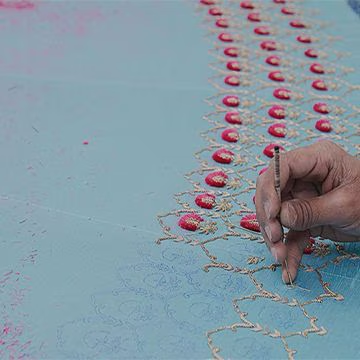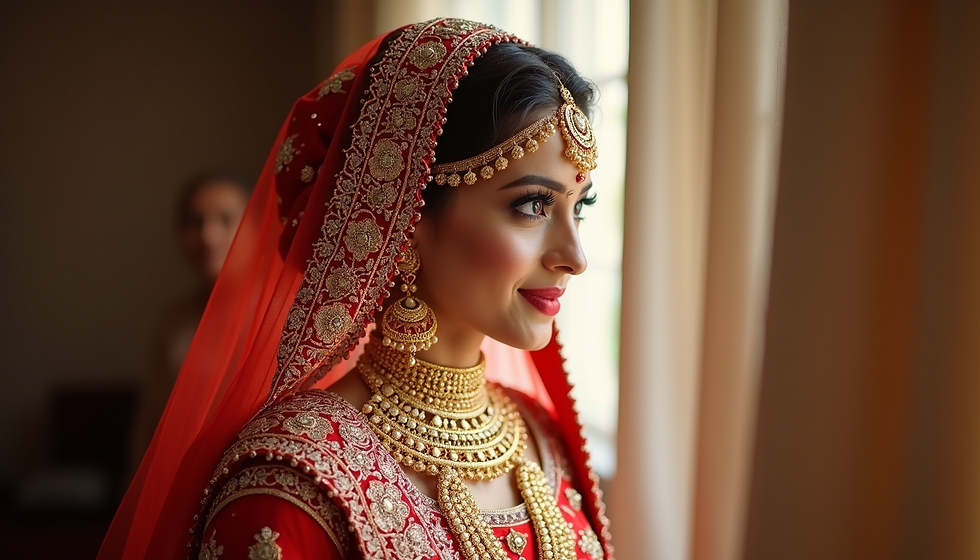Zardosi Work in Punjabi Fashion: Traditional Embroidery at it's Finest
- Harpreet
- Aug 11
- 3 min read
Explore the rich history and craftmanship of Zardosi embroidery in Punjabi fashion. Learn how it's made and why it's perfect for Punjabi suits.
In the rich tapestry of Indian craftsmanship, Zardosi embroidery holds a regal place. Known for its opulence, precision, and elegance, Zardosi work has not only survived centuries of fashion evolution but continues to thrive—especially in Punjabi fashion. From bridal Punjabi suits to festive salwar kameez, Zardosi embroidery transforms every outfit into a masterpiece.
What is Zardosi Embroidery?
Zardosi (also known as Zardozi or Zari ) is an intricate type of hand embroidery that uses metallic threads—traditionally gold and silver—to create raised, textured patterns on fabric.

The embroidery style made its way to India during the Mughal era and quickly became popular in the courts of emperors and nawabs. Artisans, known as karigars, would spend days or even weeks embellishing garments, accessories, and home décor with Zardosi.
History of Zardosi in Punjabi Fashion
Zardozi embroidery is a traditional and opulent form of needlework that originated in ancient Persia and later flourished in India, particularly during the Mughal era.
The term "Zardozi" comes from the Persian words "zar" (gold) and "dozi" (embroidery).
The term Zardosi, reflecting the craft’s use of gold and silver threads to create intricate patterns. It was introduced to India by Persian craftsmen and gained prominence under Emperor Akbar in the 16th century, who patronized skilled artisans to embellish royal garments, wall hangings, and ceremonial objects with elaborate designs. Zardozi reached its peak as a symbol of luxury and nobility, adorning the wardrobes of emperors and the interiors of royal courts.

While Zardosi's roots lie in Persian and Mughal traditions, it was warmly embraced by the Punjabi culture, especially in bridal and festive wear. In Punjab, where color and grandeur are central to fashion, Zardosi fits perfectly. Over time, it evolved into a fusion art—mixing traditional Zardosi techniques with Punjabi design sensibilities, especially on fabrics like silk, velvet, georgette, and chiffon.
In the late 20th century, Zardosi began to appear frequently on Punjabi suits, especially those worn for weddings, religious ceremonies, and formal events. Today, this embroidery continues to be a symbol of sophistication and heritage in modern Punjabi wardrobes.
How Zardosi Embroidery is Created
Creating Zardosi embroidery is a time-intensive, skill-driven process. Here’s a look at how this timeless craft is brought to life:
Fabric Selection: Rich fabrics like silk, velvet, and satin are commonly used as they hold the heavy embellishments well.
Design Tracing: A pre-drawn pattern is traced onto the fabric using chalk powder or tracing paper.
Embroidery Frame Setup: The fabric is tightly secured onto a wooden frame or adda to allow precise needlework.
Thread and Material Preparation: Artisans use metallic threads (gold, silver, or copper), sequins, beads, pearls, and stones.
The Embroidery Process: Using specialized needles, artisans sew the decorative elements into the fabric following the design. The Zardosi stitch involves looping the thread around metallic wires or coiled elements to create raised textures.
Finishing Touches: Once the embroidery is complete, excess threads are trimmed, and the fabric is cleaned and ironed.
Zardosi Work in Modern Punjabi Suits

Today’s fashion landscape celebrates the fusion of tradition with contemporary style. Here’s how Zardosi embroidery elevates Punjabi suits:
Bridal Punjabi Suits: Heavy Zardosi work on the kurta and dupatta adds grandeur. Gold threadwork often complements red or maroon fabrics for a rich bridal look.
Party Wear Suits: Subtle Zardosi accents on necklines, sleeves, and borders make even simple suits look festive.
Designer Punjabi Suits: High-end designers use Zardosi with modern silhouettes, fusing old-world charm with new-age aesthetics.
Whether you're wearing a Patiala salwar or an Anarkali-style suit, Zardosi embellishments instantly elevate the elegance of the outfit.
Caring for Zardosi Embroidery
Because of its delicate nature, Zardosi work requires careful handling:
Always dry-clean Zardosi garments.
Store them in a muslin cloth to avoid tarnishing.
Avoid hanging heavy embroidered suits as they may stretch or deform.
Conclusion
Zardosi embroidery is more than just needlework—it's a legacy of artistry passed down generations. In Punjabi fashion, it has found a special place, adding depth and royalty to traditional Punjabi suits. Whether you're dressing for a wedding or a festive celebration, a Zardosi-embroidered suit is a timeless choice that blends tradition, luxury, and elegance.











Comments